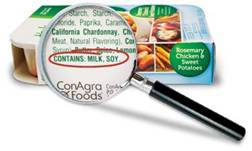Decoding Dairy
The last nutrition blog post covered why we don’t need to worry about dairy as a calcium source, but let’s back up and review the dairy foods I’m referring to as well as some tips on choosing a milk alternative.
What is considered dairy?
Any milk or product made from the milk of a mammal is dairy. This includes everything made from cow’s milk (cheese, butter, yogurt, Kefir, sour cream, milk, ice cream) and everything made from Sheep or Goat’s milk.
Eggs are not dairy.
Eggs come from chickens. Dairy comes from cows. Although plenty of people have egg allergies or intolerances, they do not need to be eliminated on a dairy free diet. They come from a totally different animal.
What is casein?
Casein is a word many people who have kids with special needs will hear often. Especially for kiddos with any sort of developmental delay, one of the main dietary interventions is a gluten free/casein free diet. Casein is the main protein in all dairy products. So you may have something that is casein free but not dairy free because it also contains whey (the other protein in dairy). Anything that is dairy free will always be casein free. That’s why I tend to use the language of gluten free/dairy free diet rather than casein free. More products in the store are labeled “dairy free” than they are “casein free.” However, you will see “casein free” label on some deli meat products, which is telling you that there was no casein used in the processing of the meat or in the casing of something like sausage. This is helpful since meat is inherently casein/dairy free and so if sausage is then processed with casein, you could miss it thinking “meats isn’t diary”. Your thought process is correct, but they were sneaky and added things to the foods. This is another reason to eat foods as close to their original state as often as possible. No pesky additives to worry about.
At the end of the day, the easiest way to avoid the problems associated with dairy is to look for “dairy free” recipes. Most recipes labeled “casein free” from resources for children with Autism are also dairy free.
On your food label you are looking for any milk containing ingredients and most processed foods will have the allergens listed at the end of the ingredients list like this:
Milk Alternatives
Especially when switching kids from cow’s milk to a dairy free diet, it’s nice to have something else to put in their cup besides the cow’s milk. Many doctors are still recommending Soy milk as a dairy alternative. Techinically, it is a dairy alternative, but I don’t consider it a viable option because of all the clearly established negative effects of non-fermented, processed Soy.
There are 3 other acceptable dairy alternatives which are coconut, almond, and rice milk; but I only like 2 of them- Coconut and Almond milk.
Coconut milk is my top pick since some people have nut allergies to contend with which takes points away from the Almond milk. Additionally, Coconut milk has some of the good things (medium- chain- fatty acids) that coconut has to offer -bonus point for coconut milk.
Almond milk tastes better to most people and is perfectly acceptable, but try, try, try to stay away from the flavored ones (same goes for the Coconut milk) since they have added sugar. I often hear, “but Billy will only drink the Chocolate flavor.” Well, it’s not a necessary part of his diet and only adding sugar so stop offering flavored milk and if he/she stops drinking it all together just let the option be water.
Both Coconut and Almond milk are fortified with Vitamin D and Calcium, which will keep your doctor happy :)
My family switches back and forth so we get some of the benefits from the coconut milk some of the time, even though we prefer the Almond milk.
Rice milk is just pointless in my opinion. It’s thin, tasteless, and has over DOUBLE the carbohydrates of the other two options. We all (kids and adults) need to keep our blood sugars stable for many reasons, and drinks with high carbohydrate content just complicate the situation. See the comparison below:
So there you have it. My recommendation for a milk alternative is Coconut or Almond milk.
Now, some people get their panties in a wad about the guar gum or carageenan used in Coconut and Almond milk as thickening agents. Yes, they are additives and not the 100% best things in the world, but compared to what dairy is doing to some of our bodies, it seems like a pretty good trade off in my opinion. The optimal/ideal solution would be to make your own coconut or almond milk from plain ol’ almond and a whole coconut. I’ve actually had friends try it and they weren’t fans of the process and the mess, but I have read plenty of bloggers who SWEAR it’s SO easy. If you’ve got the time, energy and a pioneering spirit- GO FOR IT (and let me know how it goes)! But it’s personally not a priority for me and as a holistic nutrition professional, I think we’ve got bigger fish to fry.
Now it’s your turn! What nutrition topics do you want more information about? What is overwhelming about your transition to whole foods or gluten free/dairy free living? How can I help you? Leave your ideas in the comments section.
Remember, individual consults are available- contact me at bpage@marianhopecenter.org and our monthly Nutritional Management Support Group is a great way to learn from other parents who are making real food changes in their families. The Support Group meets on the first Wednesday of each month at 6:30 PM at Marian Hope Center and everyone is welcome. Our June meeting has been moved to Friday, June 8 at Cafe Gratitude. Please join us!



Hi there. Thank you so much for your blogs! They have been very helpful to me in this new transition stage of gluten/dairy free living. As someone who is relatively new to this, I find it a bit overwhelming all the things you need to change in recipes to get the best benefit and still make it taste similar. Also, being on a budget, it can be rather pricy. Any suggestions on recipes that are good for transitioning into dairy free? Any good alternative swap outs? Thanks again!
Tina-
Sorry for the delay in responding here! I’m so glad these blogs have been helpful! I am available for private appointments to help you through these transitions- email me if you’re interested- bpage@marianhopecenter.org.
As for recipes to transition to dairy free, this is one I love for summer desserts- http://www.paleocupboard.com/fresh-berries-with-whipped-coconut-cream.html
Almond milk works well to substitute in almost any recipe. As far as cheese alternatives, many families have found some of the non-dairy, non-soy cheese alternatives useful in transition, but in my opinion, they are expensive and not the same as the real thing for me so I’d rather just not use cheese. That means for tacos or taco salad, we just use salsa and guac and smashed pinto beans for more savory options.
For Italian food, we do meatballs with tomato sauce and broccoli and haven’t missed the cheese.
We can have an appointment at your home to talk more in-depth about what will work well specifically for your family
It is rare to find somone who really knows their stuff. Good job.
Thanks Kendall! Spread the word! I’d love to help more families and I do in-home consults too for anyone- not just MHC familes.